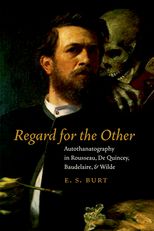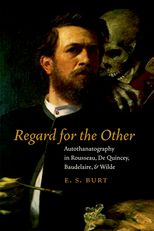Regard for the Other: Autothanatography in Rousseau, De Quincey, Baudelaire, and Wilde
Regard for the Other: Autothanatography in Rousseau, De Quincey, Baudelaire, and Wilde
Cite
Abstract
Although much has been written on autobiography, the same cannot be said of autothanatography, the writing of one's death. This study starts from the deconstructive premise that autobiography is aporetic, not or not only a matter of a subject strategizing with language to produce an exemplary identity but a matter also of its responding to an exorbitant call to write its death. The I-dominated representations of particular others and of the privileged other to whom a work is addressed, must therefore be set against an alterity plaguing the I from within or shadowing it from without. This alterity makes itself known in writing as the potential of the text to carry messages that remain secret to the confessing subject. Anticipation of the potential for the confessional text to say what Augustine calls “the secret I do not know,” the secret of death, engages the autothanatographical subject in a dynamic, inventive, and open-ended process of identification. The subject presented in these texts is not one that has already evolved an interior life that it seeks to reveal to others, but one that speaks to us as still in process. Through its exorbitant response, it gives intimations of an interiority and an ethical existence to come. Baudelaire emerges as a central figure for this understanding of autobiography as autothanatography through his critique of the narcissism of a certain Rousseau, his translation of De Quincey's confessions, with their vertiginously ungrounded subject-in-construction, and his artistic practice of self-conscious, thorough-going doubleness.
-
Front Matter
- Introduction. A Clutch of Brothers: Alterity and Autothanatography
-
I Autobiography Interrupted
-
II Writing Death, with Regard to the Other
-
End Matter
Sign in
Personal account
- Sign in with email/username & password
- Get email alerts
- Save searches
- Purchase content
- Activate your purchase/trial code
Institutional access
-
Sign in through your institution
- Sign in with a library card Sign in with username/password Recommend to your librarian
Institutional account management
Sign in as administratorPurchase
Our books are available by subscription or purchase to libraries and institutions.
Purchasing information| Month: | Total Views: |
|---|---|
| November 2022 | 1 |
| December 2022 | 1 |
| July 2023 | 1 |




Get help with access
Institutional access
Access to content on Oxford Academic is often provided through institutional subscriptions and purchases. If you are a member of an institution with an active account, you may be able to access content in one of the following ways:
IP based access
Typically, access is provided across an institutional network to a range of IP addresses. This authentication occurs automatically, and it is not possible to sign out of an IP authenticated account.
Sign in through your institution
Choose this option to get remote access when outside your institution. Shibboleth/Open Athens technology is used to provide single sign-on between your institution’s website and Oxford Academic.
If your institution is not listed or you cannot sign in to your institution’s website, please contact your librarian or administrator.
Sign in with a library card
Enter your library card number to sign in. If you cannot sign in, please contact your librarian.
Society Members
Society member access to a journal is achieved in one of the following ways:
Sign in through society site
Many societies offer single sign-on between the society website and Oxford Academic. If you see ‘Sign in through society site’ in the sign in pane within a journal:
If you do not have a society account or have forgotten your username or password, please contact your society.
Sign in using a personal account
Some societies use Oxford Academic personal accounts to provide access to their members. See below.
Personal account
A personal account can be used to get email alerts, save searches, purchase content, and activate subscriptions.
Some societies use Oxford Academic personal accounts to provide access to their members.
Viewing your signed in accounts
Click the account icon in the top right to:
Signed in but can't access content
Oxford Academic is home to a wide variety of products. The institutional subscription may not cover the content that you are trying to access. If you believe you should have access to that content, please contact your librarian.
Institutional account management
For librarians and administrators, your personal account also provides access to institutional account management. Here you will find options to view and activate subscriptions, manage institutional settings and access options, access usage statistics, and more.